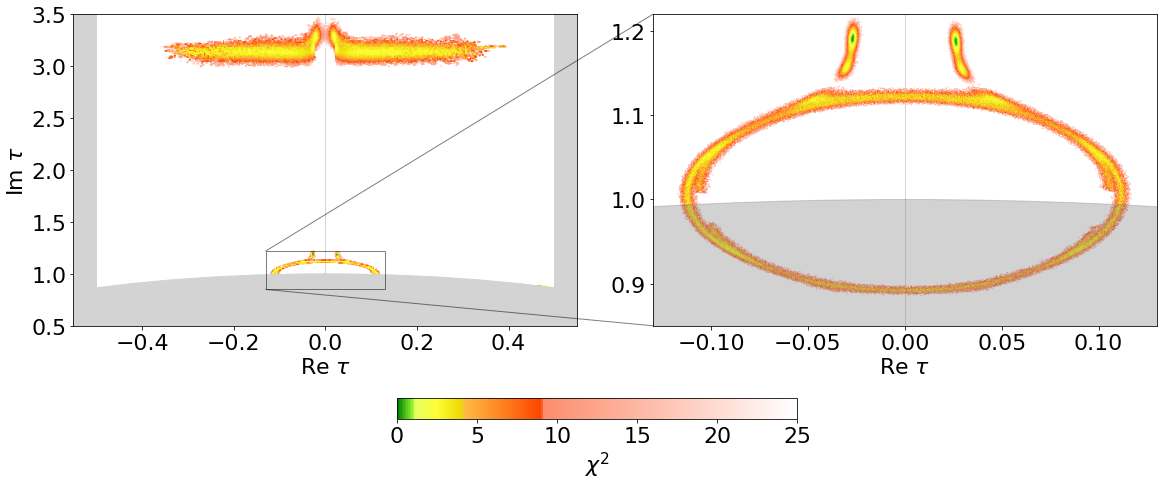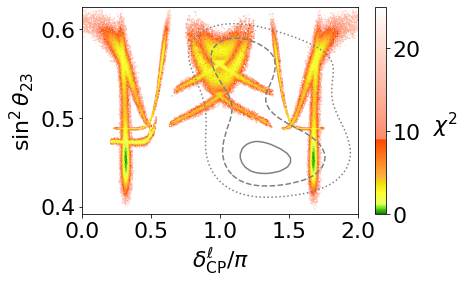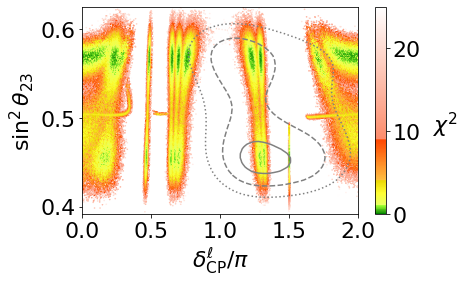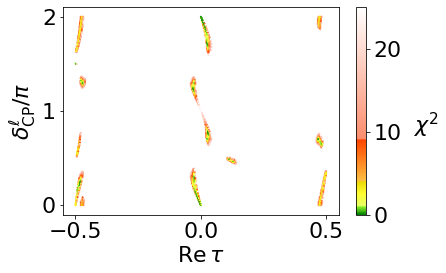The Weinberg Operator Model of arXiv:2006.03058#
This example is based on the paper “Double Cover of Modular S4 for Flavour Model Building” from P. P. Novichkov, J. T. Penedo, and S. T. Petcov available under https://arxiv.org/pdf/2006.03058. We will study their Weinberg Operator Model introduced in section 6.1 of the paper and try to reproduce their model fitting results.
Import#
# Import the modelfitting module of FlavorPy
import flavorpy.modelfitting as mf
# We will also need numpy and pandas
import numpy as np
import pandas as pd
pd.set_option('display.max_columns', None) # This pandas setting allows us to see all columns
import cmath
Mass matrices#
First we need to define a lot of modular forms. See eqs. (3.3), (3.14), and (3.15) in the paper.
### Weight 1/2 modular forms
def theta(tau):
q = cmath.exp(2j*cmath.pi*tau/4)
return 1 + 2*q**4 + 2*q**16
def eps(tau):
q = cmath.exp(2j*cmath.pi*tau/4)
return 2*q + 2*q**9 + 2*q**25
### Weight 3 modular forms
# Weight 3, rep 1hatprime
def Y31hp1(tau):
return cmath.sqrt(3) * (eps(tau) * theta(tau)**5 - eps(tau)**5 * theta(tau))
# Weight 3, rep 3hat
def Y33h1(tau):
return eps(tau)**5 * theta(tau) + eps(tau) * theta(tau)**5
def Y33h2(tau):
return 1/2/cmath.sqrt(2) * (5 * eps(tau)**2 * theta(tau)**4 - eps(tau)**6)
def Y33h3(tau):
return 1/2/cmath.sqrt(2) * (theta(tau)**6 - 5 * eps(tau)**4 * theta(tau)**2)
# Weight 3, rep 3hatprime
def Y33hp1(tau):
return 1/2 * (-4 * cmath.sqrt(2) * eps(tau)**3 * theta(tau)**3)
def Y33hp2(tau):
return 1/2 * (theta(tau)**6 + 3 * eps(tau)**4 * theta(tau)**2)
def Y33hp3(tau):
return 1/2 * (-3 * eps(tau)**2 * theta(tau)**4 - eps(tau)**6)
### Weight 4 modular forms
# Weight 4, rep 1
def Y411(tau):
return 1/2/cmath.sqrt(3) * (theta(tau)**8 + 14 * eps(tau)**4 * theta(tau)**4 + eps(tau)**8)
# Weight 4, rep 2
def Y421(tau):
return 1/4 * (theta(tau)**8 - 10 * eps(tau)**4 * theta(tau)**4 + eps(tau)**8)
def Y422(tau):
return cmath.sqrt(3) * (eps(tau)**2 * theta(tau)**6 + eps(tau)**6 * theta(tau)**2)
# Weight 4, rep 3
def Y431(tau):
return 3/2 * (eps(tau)**2 * theta(tau)**6 - eps(tau)**6 * theta(tau)**2)
def Y432(tau):
return 3/2/cmath.sqrt(2) * (eps(tau)**3 * theta(tau)**5 - eps(tau)**7 * theta(tau))
def Y433(tau):
return 3/2/cmath.sqrt(2) * (-eps(tau) * theta(tau)**7 + eps(tau)**5 * theta(tau)**3)
Then we can define the mass matrices. See eqs. (6.5), (6.6) or (6.7), (6.8) or Appendix E of the paper.
def Me(params):
tau = params['Retau'] + 1j * params['Imtau']
Y31hp1x = Y31hp1(tau)
Y33h1x = Y33h1(tau)
Y33h2x = Y33h2(tau)
Y33h3x = Y33h3(tau)
Y33hp1x = Y33hp1(tau)
Y33hp2x = Y33hp2(tau)
Y33hp3x = Y33hp3(tau)
return np.transpose((1/cmath.sqrt(3) * np.array([[Y31hp1x, 0, 0],
[0, 0, Y31hp1x],
[0, Y31hp1x, 0]], dtype=complex)
+ params['a2t']/cmath.sqrt(6) * np.array([[0, -Y33hp2x, Y33hp3x],
[-Y33hp2x, -Y33hp1x, 0],
[Y33hp3x, 0, Y33hp1x]], dtype=complex)
+ params['a3t']/cmath.sqrt(6) * np.array([[0, Y33h3x, -Y33h2x],
[-Y33h3x, 0, Y33h1x],
[Y33h2x, -Y33h1x, 0]], dtype=complex)
))
def Mn(params):
tau = params['Retau'] + 1j * params['Imtau']
Y411x = Y411(tau)
Y421x = Y421(tau)
Y422x = Y422(tau)
Y431x = Y431(tau)
Y432x = Y432(tau)
Y433x = Y433(tau)
return params['n_scale']*(1/cmath.sqrt(3) * np.array([[Y411x, 0, 0],
[0, 0, Y411x],
[0, Y411x, 0]], dtype=complex)
- params['g2t']/2/cmath.sqrt(3) * np.array([[2 * Y421x, 0, 0],
[0, cmath.sqrt(3) * Y422x, -Y421x],
[0, -Y421x, cmath.sqrt(3)*Y422x]], dtype=complex)
+ params['g3t']/cmath.sqrt(6) * np.array([[0, -Y432x, Y433x],
[-Y432x, -Y431x, 0],
[Y433x, 0, Y431x]], dtype=complex)
)
Parameter space#
# Sampling functions
def lin_sampling(low=0, high=1):
def fct():
return np.random.uniform(low=low, high=high)
return fct
def const_sampling(value=0):
def fct():
return value
return fct
# Constructing the parameter space
ParamSpace = mf.ParameterSpace()
ParamSpace.add_dim(name='Retau', sample_fct=lin_sampling(low=-0.5, high=0.5), min=-0.5, max=0.5)
ParamSpace.add_dim(name='Imtau', sample_fct=lin_sampling(low=0.866, high=2), min=0.866, max=3.5)
ParamSpace.add_dim(name='a2t', sample_fct=lin_sampling(low=-10, high=10), min=-10, max=10)
ParamSpace.add_dim(name='a3t', sample_fct=lin_sampling(low=-10, high=10), min=-10, max=10)
ParamSpace.add_dim(name='g2t', sample_fct=lin_sampling(low=-10, high=10), min=-10, max=10)
ParamSpace.add_dim(name='g3t', sample_fct=lin_sampling(low=-10, high=10), min=-10, max=10)
ParamSpace.add_dim(name='n_scale', sample_fct=const_sampling(1.), vary=False)
Experimental data#
Although the paper uses the experimental data of https://arxiv.org/pdf/2003.08511, we will use the recent results of NuFit v5.3 (see http://www.nu-fit.org/?q=node/278) in the following
ExperimentalData_NO = mf.NuFit53_NO
ExperimentalData_IO = mf.NuFit53_IO
Model construction#
Since the paper does not consider the experimental data on the CPV angle ‘d/pi’ when fitting the model, we will also omit it here
MyModel_NO = mf.FlavorModel(name='MyModel_NO',
mass_matrix_e=Me,
mass_matrix_n=Mn,
parameterspace=ParamSpace,
ordering='NO',
experimental_data=ExperimentalData_NO,
fitted_observables=['me/mu','mu/mt','s12^2', 's13^2', 's23^2', 'm21^2', 'm3l^2'])
MyModel_IO = MyModel_NO.copy()
MyModel_IO.ordering = 'IO'
MyModel_IO.name = 'MyModel_IO'
MyModel_IO.experimental_data = ExperimentalData_IO
Fitting#
Let us now scan the parameter space to find some viable points in the parameter space that yield observables, which are in agreement with the experimental data.
Normal Ordering#
Fitting around 100 random points, which takes about 5 minutes, seems sufficient to find a lot of minima with \(\chi^2<1\)
# Running the fit. Takes about 5 minutes.
# Don't worry about warnings that might pop up when running this command. Only valid points will be further processed.
df_NO = MyModel_NO.make_fit(points=100)
df_NO.head(5)
| chisq | chisq_dimless | Retau | Imtau | a2t | a3t | g2t | g3t | n_scale | me/mu | mu/mt | s12^2 | s13^2 | s23^2 | d/pi | r | m21^2 | m3l^2 | m1 | m2 | m3 | eta1 | eta2 | J | Jmax | Sum(m_i) | m_b | m_bb | nscale | |
|---|---|---|---|---|---|---|---|---|---|---|---|---|---|---|---|---|---|---|---|---|---|---|---|---|---|---|---|---|---|
| 0 | 0.001207 | 0.000735 | 0.026443 | 1.187458 | 1.730160 | 2.768355 | 3.080545 | -1.631087 | 1.0 | 0.004801 | 0.056483 | 0.305000 | 0.022199 | 0.455049 | 0.318025 | 0.029591 | 0.000074 | 0.002506 | 0.014308 | 0.016699 | 0.052061 | 1.030516 | 1.995178 | 0.028091 | 0.033402 | 0.083068 | 0.016856 | 0.014052 | 0.072506 |
| 1 | 0.001711 | 0.001181 | 0.026443 | 1.187450 | 1.730158 | 2.768588 | 3.080593 | -1.631214 | 1.0 | 0.004801 | 0.056523 | 0.305000 | 0.022196 | 0.455013 | 0.318039 | 0.029590 | 0.000074 | 0.002506 | 0.014308 | 0.016699 | 0.052061 | 1.030494 | 1.995186 | 0.028089 | 0.033399 | 0.083068 | 0.016855 | 0.014052 | 0.072504 |
| 2 | 0.002458 | 0.000001 | -0.026727 | 1.192163 | 1.733958 | 2.771002 | 3.097690 | -1.653116 | 1.0 | 0.004800 | 0.056499 | 0.309623 | 0.022280 | 0.452129 | 1.678225 | 0.029581 | 0.000074 | 0.002506 | 0.014550 | 0.016906 | 0.052132 | 0.967485 | 0.006005 | -0.028454 | 0.033582 | 0.083588 | 0.017077 | 0.014237 | 0.072636 |
| 3 | 0.002458 | 0.000001 | -0.026727 | 1.192163 | 1.733958 | 2.771002 | 3.097690 | -1.653116 | 1.0 | 0.004800 | 0.056499 | 0.309623 | 0.022280 | 0.452129 | 1.678225 | 0.029581 | 0.000074 | 0.002506 | 0.014550 | 0.016906 | 0.052132 | 0.967485 | 0.006005 | -0.028454 | 0.033582 | 0.083588 | 0.017077 | 0.014237 | 0.072636 |
| 4 | 0.002458 | 0.000001 | -0.026727 | 1.192163 | 1.733958 | 2.771002 | 3.097690 | -1.653116 | 1.0 | 0.004800 | 0.056499 | 0.309623 | 0.022280 | 0.452129 | 1.678225 | 0.029581 | 0.000074 | 0.002506 | 0.014550 | 0.016906 | 0.052132 | 0.967485 | 0.006005 | -0.028454 | 0.033582 | 0.083588 | 0.017077 | 0.014237 | 0.072636 |
### Point in the paper
paper_point_NO = {'Retau':0.029725, 'Imtau':1.1181, 'n_scale':1, #'n_scale':0.076533,
'a2t':1.7303, 'a3t':-2.7706, 'g2t':2.716, 'g3t':-0.35786}
MyModel_NO.get_obs(paper_point_NO)
{'me/mu': 0.0049421699542366885,
'mu/mt': 0.05648917752606122,
's12^2': 0.3050120711014076,
's13^2': 0.02227053474308995,
's23^2': 0.5450767487159297,
'd/pi': 1.0487709548688628,
'r': 0.02912708311826326,
'm21^2': 7.356079868874301e-05,
'm3l^2': 0.002525512025700195,
'm1': 0.00738634326918084,
'm2': 0.011318960446035498,
'm3': 0.05079439036537764,
'eta1': 0.24865416225269987,
'eta2': 1.0042563790059496,
'J': -0.0051055157836726785,
'Jmax': 0.033452537478177814,
'Sum(m_i)': 0.06949969408059398,
'm_b': 0.011592155003347798,
'm_bb': 0.006559895559779271,
'nscale': 0.07660247267356302}
Inverted Ordering#
Fitting around 100 random points, which takes about 5 minutes, seems sufficient to find a lot of minima with \(\chi^2<1\)
# Running the fit. Takes about 5 minutes.
# Don't worry about warnings that might pop up when running this command. Only valid points will be further processed.
df_IO = MyModel_IO.make_fit(points=100)
df_IO.head(5)
| chisq | chisq_dimless | Retau | Imtau | a2t | a3t | g2t | g3t | n_scale | me/mu | mu/mt | s12^2 | s13^2 | s23^2 | d/pi | r | m21^2 | m3l^2 | m1 | m2 | m3 | eta1 | eta2 | J | Jmax | Sum(m_i) | m_b | m_bb | nscale | |
|---|---|---|---|---|---|---|---|---|---|---|---|---|---|---|---|---|---|---|---|---|---|---|---|---|---|---|---|---|---|
| 0 | 0.002987 | 0.000443 | 0.468330 | 1.742981 | 2.092636 | 2.630521 | 1.918893 | 6.552312 | 1.0 | 0.004799 | 0.056543 | 0.309623 | 0.022249 | 0.569998 | 0.699973 | -0.029813 | 0.000074 | -0.002486 | 0.049152 | 0.04990 | 0.002066 | 0.163506 | 0.081986 | 0.027009 | 0.033383 | 0.101119 | 0.049847 | 0.046958 | 0.101288 |
| 1 | 0.002992 | 0.000447 | 0.468330 | 1.742981 | 2.092635 | 2.630521 | 1.918893 | 6.552312 | 1.0 | 0.004799 | 0.056543 | 0.309623 | 0.022250 | 0.569998 | 0.699973 | -0.029813 | 0.000074 | -0.002486 | 0.049152 | 0.04990 | 0.002066 | 0.163506 | 0.081986 | 0.027009 | 0.033383 | 0.101119 | 0.049847 | 0.046958 | 0.101288 |
| 2 | 0.003036 | 0.000503 | 0.468330 | 1.742981 | 2.092637 | 2.630519 | 1.918893 | 6.552312 | 1.0 | 0.004798 | 0.056543 | 0.309623 | 0.022249 | 0.569998 | 0.699975 | -0.029813 | 0.000074 | -0.002486 | 0.049152 | 0.04990 | 0.002066 | 0.163504 | 0.081985 | 0.027008 | 0.033382 | 0.101119 | 0.049847 | 0.046958 | 0.101288 |
| 3 | 0.003371 | 0.001099 | 0.468837 | 1.743138 | 2.092861 | 2.630640 | 1.917660 | 6.551518 | 1.0 | 0.004799 | 0.056574 | 0.305000 | 0.022200 | 0.570000 | 0.704986 | -0.029764 | 0.000074 | -0.002488 | 0.049173 | 0.04992 | 0.002061 | 0.160452 | 0.079565 | 0.026557 | 0.033208 | 0.101154 | 0.049871 | 0.047009 | 0.101369 |
| 4 | 0.003371 | 0.001099 | 0.468837 | 1.743138 | 2.092861 | 2.630640 | 1.917660 | 6.551518 | 1.0 | 0.004799 | 0.056574 | 0.305000 | 0.022200 | 0.570000 | 0.704986 | -0.029764 | 0.000074 | -0.002488 | 0.049173 | 0.04992 | 0.002061 | 0.160452 | 0.079565 | 0.026557 | 0.033208 | 0.101154 | 0.049871 | 0.047009 | 0.101369 |
### Point in the paper
paper_point_IO = {'Retau':0.027941, 'Imtau':1.5921, 'n_scale':1, #'n_scale':0.23558,
'a2t':1.7266, 'a3t':-2.17, 'g2t':0.4705, 'g3t':-1.2442}
MyModel_IO.get_obs(paper_point_IO)
{'me/mu': 0.004830619795663459,
'mu/mt': 0.05647840159968499,
's12^2': 0.3030936675666006,
's13^2': 0.022267180242549808,
's23^2': 0.5502850560474966,
'd/pi': 0.7827880069017603,
'r': -0.029315798940845687,
'm21^2': 7.348953808347119e-05,
'm3l^2': -0.0025068236493148498,
'm1': 0.052920922289185414,
'm2': 0.05361075968517395,
'm3': 0.019164809018266362,
'eta1': 0.1977278694922162,
'eta2': 0.26549338075520046,
'J': 0.02103681364336458,
'Jmax': 0.03335730544660353,
'Sum(m_i)': 0.12569649099262573,
'm_b': 0.05355715231024689,
'm_bb': 0.05137951379189798,
'nscale': 0.23580302931711378}
Fitting results#
Using FlavorPy we were able to find a lot of viable \(\chi^2<25\) minima for NO as well as for IO within roughly 10 minutes of computation time on a conventional desktop machine. We do not only find the minima reported in the paper, but also further minima. This might be due to the different experimental data used in the fit and because we scanned a bigger region of the parameter space.
Exploring minima with MCMC#
Finally, let us further explore the vicinity of the minima using a Markov Chain Monte Carlo (MCMC) sampler.
Normal Ordering#
# Selecting the minima which will be explored with MCMC.
# This still has to be done manually, in this case the distinct minima are:
df_NO_for_mcmc = df_NO.loc[[0, 2, 30, 38, 40, 42, 45, 46, 52, 61]] # <--------- adjust this for your results!!
df_NO_for_mcmc
| chisq | chisq_dimless | Retau | Imtau | a2t | a3t | g2t | g3t | n_scale | me/mu | mu/mt | s12^2 | s13^2 | s23^2 | d/pi | r | m21^2 | m3l^2 | m1 | m2 | m3 | eta1 | eta2 | J | Jmax | Sum(m_i) | m_b | m_bb | nscale | |
|---|---|---|---|---|---|---|---|---|---|---|---|---|---|---|---|---|---|---|---|---|---|---|---|---|---|---|---|---|---|
| 0 | 0.001207 | 0.000735 | 0.026443 | 1.187458 | 1.730160 | 2.768355 | 3.080545 | -1.631087 | 1.0 | 0.004801 | 0.056483 | 0.305000 | 0.022199 | 0.455049 | 0.318025 | 0.029591 | 0.000074 | 0.002506 | 0.014308 | 0.016699 | 0.052061 | 1.030516 | 1.995178 | 0.028091 | 0.033402 | 0.083068 | 0.016856 | 0.014052 | 0.072506 |
| 2 | 0.002458 | 0.000001 | -0.026727 | 1.192163 | 1.733958 | 2.771002 | 3.097690 | -1.653116 | 1.0 | 0.004800 | 0.056499 | 0.309623 | 0.022280 | 0.452129 | 1.678225 | 0.029581 | 0.000074 | 0.002506 | 0.014550 | 0.016906 | 0.052132 | 0.967485 | 0.006005 | -0.028454 | 0.033582 | 0.083588 | 0.017077 | 0.014237 | 0.072636 |
| 30 | 1.708405 | 1.705966 | 0.044772 | 1.119144 | 1.733755 | -2.772553 | 2.674447 | -0.441267 | 1.0 | 0.004800 | 0.056500 | 0.305000 | 0.022280 | 0.564698 | 1.131871 | 0.029581 | 0.000074 | 0.002506 | 0.007954 | 0.011721 | 0.050688 | 0.258953 | 0.998279 | -0.013410 | 0.033313 | 0.070363 | 0.011952 | 0.006009 | 0.077315 |
| 38 | 1.885333 | 1.875204 | 0.476922 | 0.877216 | -3.625034 | 0.078474 | -1.242683 | -3.367152 | 1.0 | 0.004795 | 0.057331 | 0.309623 | 0.022110 | 0.483693 | 0.497317 | 0.029561 | 0.000074 | 0.002507 | 0.135611 | 0.135884 | 0.144559 | 1.849964 | 0.280012 | 0.033594 | 0.033595 | 0.416054 | 0.135904 | 0.054553 | 0.170925 |
| 40 | 1.937927 | 1.863562 | 0.025545 | 3.189923 | -0.983153 | 1.446903 | 4.613140 | -0.166363 | 1.0 | 0.004779 | 0.055446 | 0.309712 | 0.022456 | 0.563993 | 0.581216 | 0.029655 | 0.000074 | 0.002503 | 0.592886 | 0.592948 | 0.594993 | 0.384810 | 0.550164 | 0.032500 | 0.033588 | 1.780827 | 0.592953 | 0.528214 | 1.188512 |
| 42 | 1.975067 | 1.969849 | 0.019061 | 3.291931 | -1.159061 | 1.771834 | 4.614620 | -0.145069 | 1.0 | 0.004866 | 0.055597 | 0.305000 | 0.022280 | 0.570638 | 1.716079 | 0.029572 | 0.000074 | 0.002506 | 0.692445 | 0.692499 | 0.694253 | 0.193904 | 0.571098 | -0.025886 | 0.033259 | 2.079197 | 0.692503 | 0.368505 | 1.387247 |
| 45 | 2.146873 | 2.145132 | -0.150694 | 3.140511 | -0.999689 | 1.387357 | 4.608383 | -0.019511 | 1.0 | 0.004800 | 0.056568 | 0.309617 | 0.022206 | 0.487934 | 1.612380 | 0.029583 | 0.000074 | 0.002506 | 0.642293 | 0.642351 | 0.644241 | 1.430965 | 1.527874 | -0.031596 | 0.033673 | 1.928886 | 0.642355 | 0.616305 | 1.288508 |
| 46 | 2.183422 | 2.175304 | 0.000015 | 1.120671 | 1.733568 | -2.160260 | 2.735981 | -0.336574 | 1.0 | 0.004800 | 0.056203 | 0.310586 | 0.022200 | 0.576002 | 1.000018 | 0.029565 | 0.000074 | 0.002507 | 0.007173 | 0.011205 | 0.050578 | 0.000170 | 1.000003 | -0.000002 | 0.033316 | 0.068955 | 0.011456 | 0.009377 | 0.076122 |
| 52 | 2.423941 | 2.416746 | 0.002439 | 0.892098 | 1.733577 | -2.160417 | 2.734927 | -0.344948 | 1.0 | 0.004830 | 0.056174 | 0.307714 | 0.022193 | 0.577773 | 0.995984 | 0.029481 | 0.000074 | 0.002510 | 0.007231 | 0.011238 | 0.050621 | 1.995052 | 1.028522 | 0.000419 | 0.033207 | 0.069090 | 0.011485 | 0.009371 | 0.048278 |
| 61 | 2.614237 | 2.612816 | 0.246669 | 3.170182 | -1.007332 | 1.395057 | 4.611126 | -0.009006 | 1.0 | 0.004734 | 0.054022 | 0.307927 | 0.022271 | 0.488152 | 0.320214 | 0.029588 | 0.000074 | 0.002506 | 0.751820 | 0.751869 | 0.753484 | 1.576076 | 1.472051 | 0.028440 | 0.033670 | 2.257173 | 0.751873 | 0.713261 | 1.507008 |
# Sampling takes about 10 minutes for every minimum that is explored
df_mcmc_NO = MyModel_NO.mcmc_fit(df_NO_for_mcmc, mcmc_steps=20000, progress=False)
df_mcmc_NO = MyModel_NO.complete_fit(df_mcmc_NO)
Inverted Ordering#
# Selecting the minima which will be explored with MCMC.
# This still has to be done manually, in this case the distinct minima are:
df_IO_for_mcmc = df_IO.loc[[0, 6, 8, 18, 27, 35, 38, 41, 56, 66, 69, 74]] # <--------- adjust this for your results!!
df_IO_for_mcmc
| chisq | chisq_dimless | Retau | Imtau | a2t | a3t | g2t | g3t | n_scale | me/mu | mu/mt | s12^2 | s13^2 | s23^2 | d/pi | r | m21^2 | m3l^2 | m1 | m2 | m3 | eta1 | eta2 | J | Jmax | Sum(m_i) | m_b | m_bb | nscale | |
|---|---|---|---|---|---|---|---|---|---|---|---|---|---|---|---|---|---|---|---|---|---|---|---|---|---|---|---|---|---|
| 0 | 0.002987 | 0.000443 | 0.468330 | 1.742981 | 2.092636 | 2.630521 | 1.918893 | 6.552312 | 1.0 | 0.004799 | 0.056543 | 0.309623 | 0.022249 | 0.569998 | 0.699973 | -0.029813 | 0.000074 | -0.002486 | 0.049152 | 0.049900 | 0.002066 | 0.163506 | 0.081986 | 0.027009 | 0.033383 | 0.101119 | 0.049847 | 0.046958 | 0.101288 |
| 6 | 0.003497 | 0.000477 | -0.029190 | 1.584797 | 1.737999 | -2.762588 | 0.465947 | -1.232394 | 1.0 | 0.004801 | 0.056502 | 0.305000 | 0.022199 | 0.570003 | 1.228115 | -0.029809 | 0.000074 | -0.002486 | 0.052730 | 0.053428 | 0.019201 | 1.792189 | 1.722532 | -0.021812 | 0.033207 | 0.125360 | 0.053383 | 0.051144 | 0.235015 |
| 8 | 0.003782 | 0.001026 | 0.479808 | 1.470542 | 1.736095 | 2.758823 | 0.174569 | -1.942831 | 1.0 | 0.004799 | 0.056518 | 0.305000 | 0.022206 | 0.570000 | 0.657815 | -0.029811 | 0.000074 | -0.002486 | 0.049886 | 0.050623 | 0.008770 | 1.375079 | 0.373617 | 0.029213 | 0.033212 | 0.109279 | 0.050576 | 0.049188 | 0.190790 |
| 18 | 0.004035 | 0.000005 | -0.480438 | 1.519803 | 1.736815 | 2.759106 | 2.100161 | 5.556761 | 1.0 | 0.004800 | 0.056493 | 0.309623 | 0.022249 | 0.570000 | 0.246101 | -0.029797 | 0.000074 | -0.002486 | 0.049632 | 0.050373 | 0.007141 | 1.841288 | 0.846685 | 0.023314 | 0.033382 | 0.107146 | 0.050320 | 0.048881 | 0.088387 |
| 27 | 0.005189 | 0.002140 | -0.026553 | 1.833640 | 2.095131 | 2.636730 | 1.176942 | 5.322656 | 1.0 | 0.004799 | 0.056498 | 0.309623 | 0.022248 | 0.569882 | 0.295708 | -0.029809 | 0.000074 | -0.002486 | 0.049303 | 0.050049 | 0.004361 | 1.619764 | 0.765459 | 0.026740 | 0.033383 | 0.103713 | 0.049996 | 0.044273 | 0.136882 |
| 35 | 0.018135 | 0.014002 | -0.000370 | 2.048506 | 1.491709 | 2.372927 | 1.202105 | 8.054844 | 1.0 | 0.004799 | 0.056481 | 0.309623 | 0.022249 | 0.566847 | 0.002419 | -0.029789 | 0.000074 | -0.002487 | 0.049235 | 0.049981 | 0.003374 | 1.996806 | 0.997704 | 0.000254 | 0.033412 | 0.102590 | 0.049928 | 0.048440 | 0.131178 |
| 38 | 0.065400 | 0.064381 | -0.469188 | 1.741474 | 2.087173 | 2.627730 | 1.920522 | 6.470264 | 1.0 | 0.004811 | 0.055782 | 0.304563 | 0.022184 | 0.564893 | 0.703872 | -0.029853 | 0.000074 | -0.002484 | 0.049129 | 0.049878 | 0.001944 | 0.151895 | 0.071217 | 0.026644 | 0.033229 | 0.100952 | 0.049831 | 0.046973 | 0.101813 |
| 41 | 0.315446 | 0.294528 | 0.028710 | 1.582487 | 1.737763 | -2.754625 | 0.470504 | -1.252939 | 1.0 | 0.004771 | 0.055153 | 0.303101 | 0.022290 | 0.563452 | 0.772167 | -0.029952 | 0.000074 | -0.002480 | 0.052532 | 0.053234 | 0.018813 | 0.208438 | 0.274170 | 0.021833 | 0.033273 | 0.124579 | 0.053190 | 0.051059 | 0.232995 |
| 56 | 0.600770 | 0.601285 | 0.128321 | 0.987892 | 1.449173 | 2.314813 | 5.107434 | 9.910349 | 1.0 | 0.004800 | 0.055444 | 0.309623 | 0.022066 | 0.451725 | 0.469631 | -0.029829 | 0.000074 | -0.002485 | 0.086278 | 0.086706 | 0.070943 | 1.503596 | 1.482786 | 0.033273 | 0.033425 | 0.243927 | 0.086679 | 0.085881 | 0.042222 |
| 66 | 2.730728 | 2.729943 | -0.493160 | 0.895238 | -3.392838 | 0.038645 | -2.779198 | -8.177446 | 1.0 | 0.004804 | 0.056966 | 0.309625 | 0.022250 | 0.501194 | 1.666261 | -0.029756 | 0.000074 | -0.002488 | 0.155547 | 0.155785 | 0.147583 | 0.793154 | 0.494171 | -0.029219 | 0.033715 | 0.458915 | 0.155768 | 0.098778 | 0.081623 |
| 69 | 2.770719 | 2.767333 | 0.487255 | 0.892831 | -3.521706 | -0.033377 | -2.111703 | -6.230592 | 1.0 | 0.004800 | 0.056484 | 0.305000 | 0.022249 | 0.503370 | 0.207863 | -0.029806 | 0.000074 | -0.002486 | 0.151281 | 0.151526 | 0.143087 | 0.889984 | 0.380356 | 0.020398 | 0.033573 | 0.445894 | 0.151509 | 0.060304 | 0.103553 |
| 74 | 4.292325 | 4.288877 | -0.496938 | 0.910149 | 2.071179 | -2.610895 | -1.254777 | -3.837758 | 1.0 | 0.004804 | 0.061117 | 0.304999 | 0.022501 | 0.428979 | 1.501533 | -0.029805 | 0.000074 | -0.002486 | 0.112664 | 0.112993 | 0.101397 | 0.817087 | 1.224849 | -0.033412 | 0.033412 | 0.327054 | 0.112968 | 0.050149 | 0.128636 |
# Sampling takes about 10 minutes for every minimum that is explored
df_mcmc_IO = MyModel_IO.mcmc_fit(df_IO_for_mcmc, mcmc_steps=20000, progress=False)
df_mcmc_IO = MyModel_IO.complete_fit(df_mcmc_IO)
Plotting the results#
Normal Ordering#
Moduli space#
Let us take a look on how the points are distributed over the modulispace, see also figure 2 of the paper
# Some more advanced plots
import matplotlib.pyplot as plt
def RetauImtauplot(df, gridsize=200, cmap='ocean', extent=None, sizefactor=1.5, fontsize=22,
colorbar=True, axlines=True,
zoom_in=False, zoom_in_loc=[1.15, 0, 1., 1.], zoom_in_extent=[-0.22, 0.22, 2.95, 3.45],
zoom_in_gridsize=500):
plt.rcParams.update({'font.size': fontsize})
fig, ax = plt.subplots(figsize=(sizefactor*6.18,sizefactor*3.82))
im = ax.hexbin(df['Retau'], df['Imtau'], C=df['chisq'], reduce_C_function=np.min,
gridsize=gridsize, cmap=cmap, extent=extent, vmin=0, vmax=25)
if not extent==None:
ax.set(xlim=(extent[0], extent[1]), ylim=(extent[2], extent[3]))
ax.set_xlabel(r'$\mathrm{Re}~ \tau $');
ax.set_ylabel(r'$\mathrm{Im}~ \tau $');
ax.set_aspect(abs((extent[1]-extent[0])/(extent[3]-extent[2]))*(3.82/6.18))
if axlines==True:
ax.axvline(0, color='lightgray', lw=1, zorder=0);
ax.axvline(0.5, color='lightgray', lw=1, zorder=0);
ax.axvline(-0.5, color='lightgray', lw=1, zorder=0);
ax.add_patch(plt.Circle((0,0), radius=1, facecolor='lightgray', edgecolor='lightgray'));
ax.axvspan(0.5,10, facecolor='lightgray');
ax.axvspan(-0.5,-10, facecolor='lightgray');
if zoom_in==True:
axins = ax.inset_axes(zoom_in_loc)
axins.add_patch(plt.Circle((0,0), radius=1, facecolor='gray', edgecolor='gray', alpha=0.35));
axins.hexbin(df['Retau'], df['Imtau'], C=df['chisq'], reduce_C_function=np.min,
gridsize=zoom_in_gridsize, cmap=cmap, extent=zoom_in_extent, vmin=0, vmax=25)
axins.axvline(0, color='lightgray', lw=1, zorder=0);
# sub region of the original image
[x1, x2, y1, y2] = zoom_in_extent
axins.set_xlim(x1, x2)
axins.set_ylim(y1, y2)
axins.set_xlabel(r'$\mathrm{Re}~ \tau$');
ax.indicate_inset_zoom(axins, edgecolor="black")
axins.set_aspect(abs((zoom_in_extent[1]-zoom_in_extent[0])/(zoom_in_extent[3]-zoom_in_extent[2]))*(3.82/6.18))
if colorbar==True:
cax = fig.add_axes([0.62, -0.1, 0.6, 0.05])
fig.colorbar(im, cax=cax, orientation='horizontal').set_label(r'$\chi^2$', rotation=0);#, labelpad=10);
plotargs = {'cmap':mf.flavorpy_cmap(), 'gridsize':400,
'zoom_in':True, 'zoom_in_gridsize':800, 'zoom_in_extent':[-0.13, 0.13, 0.85, 1.22]}
RetauImtauplot(df_mcmc_NO, extent=[-0.55,0.55,0.5,3.5], **plotargs)

s23^2 - d/pi#
Let us try to reproduce the first panel of figure 3 of the paper
ax = mf.plot(df_mcmc_NO, x='d/pi', y='s23^2', show_exp='2dim', gridsize=400, vmin=0, vmax=25);
ax.set_xlim(0, 2);

Retau - d/pi#
Let us see whether we can reproduce the left panel of figure 5 of the paper:
ax = mf.plot(df_mcmc_NO, x='Retau', y='d/pi', gridsize=400, vmin=0, vmax=25);
ax.set_xlim(-0.5, 0.5);

Inverted Ordering#
Moduli space#
Let us take a look on how the points are distributed over the modulispace, see also figure 2 of the paper
plotargs = {'cmap':mf.flavorpy_cmap(), 'gridsize':400,
'zoom_in':True, 'zoom_in_gridsize':300, 'zoom_in_extent':[-0.05, 0.05, 1.48, 1.72]}
RetauImtauplot(df_mcmc_IO, extent=[-0.55,0.55,0.5,3.5], **plotargs)

Appart from many additional viable regions, also the shape of the minima reported in the paper look a bit different here due to the more recent experimental data.
s23^2 - d/pi#
Let us try to reproduce the first panel of figure 4 of the paper
ax = mf.plot(df_mcmc_IO, x='d/pi', y='s23^2', show_exp='2dim', gridsize=400, vmin=0, vmax=25);
ax.set_xlim(0, 2);

Retau - d/pi#
Let us see whether we can reproduce the right panel of figure 5 of the paper:
mf.plot(df_mcmc_IO, x='Retau', y='d/pi', gridsize=300, vmin=0, vmax=25);

Conclusion#
We were able to reproduce the results of the Weinberg Operator Model of the paper with around 30 minutes of computation time on a conventional desktop machine. Further investing some 3-4 hours of computation time, we could also find and explore additional experimentally viable regions in the parameterspace of this model.